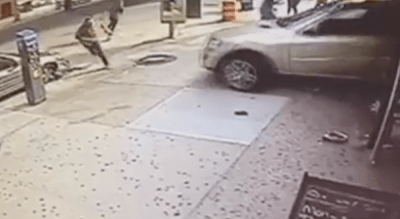Bronx Driver Who Killed Heather Lough Pleads to Reckless Driving in Exchange for Wrist Tap

The motorist who killed cyclist Heather Lough in the Bronx two years ago pled guilty last week to reckless driving. In keeping with the New York justice system’s casual attitude toward deadly traffic violence, his plea arrangement with District Attorney Darcel Clark resulted only in a nominal fine and a brief interruption of his driving privileges.
Lough, 29, was biking to her job at the New York Botanical Garden on the morning of April 27, 2016, when Robert Owens hit her with a commercial box truck. Gothamist, which obtained a copy of the criminal complaint, reported that Owens was making a left turn from NYBG onto Southern Boulevard when he drove over Lough, who was crossing Southern with the right of way.
Owens’s own account of the crash indicated he wasn’t looking where he was going. “I was exiting the Botanical Garden, making a left turn with a green traffic signal,” he told NYPD, according to DNAinfo. “I looked to my right to make sure no one was running the red light. In my completion of my left turn, I hit the woman as I turned with the front of the vehicle.”
Lough died from her injuries five days later. “She was wearing her helmet, followed the signs, and did everything right,” read a memorial page established to raise funds for her burial. “However, the driver was not paying attention, and ran over her.”
NYPD and Clark charged Owens, then 45, with misdemeanor reckless driving and a Right of Way Law violation. Both offenses are unclassified misdemeanors, the least severe category of criminal charge.
Last fall Gothamist reported that Owens challenged the constitutionality of the Right of Way Law. At some point that charge was apparently dropped or dismissed. On July 11, Owens pled to the reckless driving charge and one count of failure to exercise due care, which is a traffic infraction, according to court records. He was sentenced to $1,088 in fines and fees and a 75-day license suspension.
Because his license was suspended, rather than revoked, Owens may regain his driving privileges by filing paperwork with the state Department of Motor Vehicles.
Steve Vaccaro of Vaccaro and White, a law firm that represents crash victims, told Streetsblog the courts have interpreted state reckless driving laws in a way that benefits offenders.
“Courts have created a heightened standard for conviction under the statute of recklessness where none should exist,” Vaccaro said via email. “Given that the courts persist in reading into the reckless driving statute a culpable state of mind of recklessness, when recklessness is found — as it apparently was in this case — it should support a charge of first degree reckless endangerment, a class D felony.”
Other factors may have affected the outcome of the case.
Owens was never charged with drunk driving, but court records say his sentence included a “referral” to the state Impaired Driver Program, which is normally offered to help DWI offenders restore their driving privileges.
Another motorist, Anthony Webb, was required to take such a course after taking a life, though he wasn’t convicted of DWI. Webb was charged with driving drunk after he killed Brooklyn pedestrian Clara Heyworth in 2011, but prosecutors dropped the charge because NYPD botched the investigation. A judge ultimately ordered Webb to enter a drunk driving program as part of his sentence.
We asked Clark’s office why, absent a DWI charge, court records indicate Owens was referred to the Impaired Driver Program. In an email, a spokesperson replied that Owens was sentenced to complete an “accident prevention course” and “was never charged with any DWI related offense.”
Also, it’s unknown when NYPD dispatched the Collision Investigation Squad, a small team of investigators that, contrary to reforms promised years ago, are still deployed only when traffic violence victims die at the scene or are deemed “likely to die.”
NYPD investigators were observed taking measurements and photos near Lough’s ghost bike eight months after the crash — long after physical evidence, like skid marks, could be documented.
If NYPD somehow compromised the case against Owens, it wouldn’t be the first time a deceased crash victim was denied justice due in part to shoddy police work.
Owens is due back in court in October.
